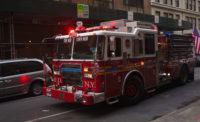AEDs not in most likely sites of cardiac arrest
Getting bystanders to use them also a hurdle

 The mismatch between where cardiac arrest is most likely to happen and where automated external defibrillators (AEDS) are most likely placed may help explain in part the low survival rate for this “significant public health problem,” according to a Canadian study published yesterday online in Annals of Emergency Medicine (“Determining Risk for Out-of-Hospital Cardiac Arrest by Location Type in a Canadian Urban Setting to Guide Future Public Access Defibrillator Placement”).
The mismatch between where cardiac arrest is most likely to happen and where automated external defibrillators (AEDS) are most likely placed may help explain in part the low survival rate for this “significant public health problem,” according to a Canadian study published yesterday online in Annals of Emergency Medicine (“Determining Risk for Out-of-Hospital Cardiac Arrest by Location Type in a Canadian Urban Setting to Guide Future Public Access Defibrillator Placement”).
“If your heart stops at a school, you’re much more likely to be near an AED,” said lead study author Steven Brooks, MD, MSc, of Queen’s University in Kingston, Canada. “The problem is that many building types – like shopping malls, hotels and race tracks – that are higher risk for cardiac arrest are poorly covered by registered AEDs. Getting bystanders to actually use the AEDs is another hurdle, but they can’t use them if they aren’t there to begin with.”
The top five locations for average annual out-of-hospital cardiac arrest were:
- race track/casino
- jail
- hotel/motel
- hostel/shelter
- convention center
The top five locations for ratio of AEDs to sites were:
- post-secondary school
- elementary and secondary school
- university or religious residence, fairground
- jail
- other educational establishment, such as trade school
(University or religious residence and fairground shared third place on the list.) Although schools were relatively lower risk for cardiac arrest, they represented nearly three-quarters (72.5 percent) of AED-covered locations in the study region (urban Toronto).
Put another way, it would take just two race tracks to yield one cardiac arrest per year, while it would take 264 elementary schools to yield one cardiac arrest per year.
In addition, some other higher risk locations have relatively poor AED coverage: Hotels/motels and hostels/shelters are ranked 3rd and 4th in risk of cardiac arrest, but ranked only 23rd and 24th in location coverage.
AED need right locations and connections
“Location-specific estimates of cardiac arrest risk from this study may guide AED deployment in other similar urban settings,” said Dr. Brooks. “A comprehensive solution to the problem of AED underuse must include strategies to optimize placement in the community. Ultimately, we need to ensure that AEDs are not only well-placed but linked to the 911 system so they can be rapidly located and used when needed.”
Dr. Brooks was supported with a Jumpstart Resuscitation Scholarship from the Heart and Stroke Foundation of Canada for his work on this study.
Annals of Emergency Medicine is the peer-reviewed scientific journal for the American College of Emergency Physicians, the national medical society representing emergency medicine. ACEP is committed to advancing emergency care through continuing education, research, and public education. Headquartered in Dallas, Texas, ACEP has 53 chapters representing each state, as well as Puerto Rico and the District of Columbia. A Government Services Chapter represents emergency physicians employed by military branches and other government agencies. For more information visit www.acep.org.
Looking for a reprint of this article?
From high-res PDFs to custom plaques, order your copy today!





